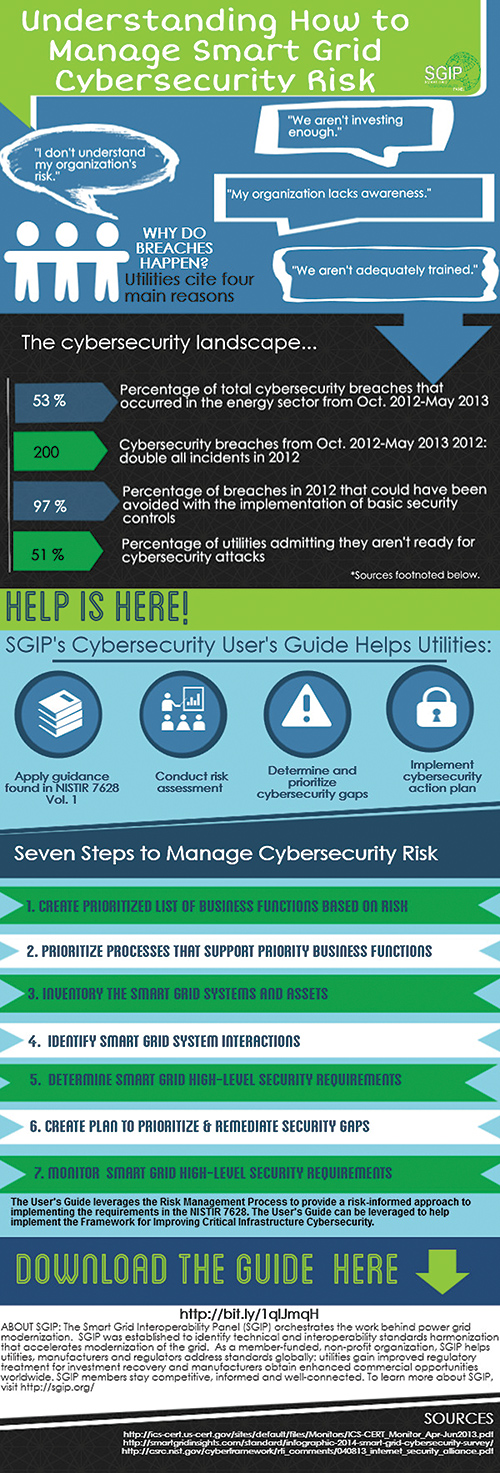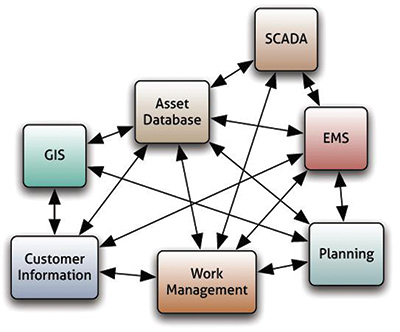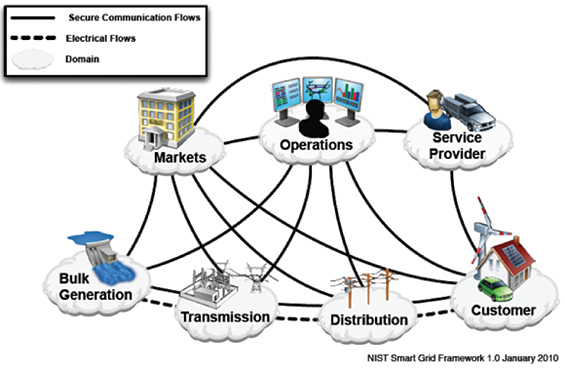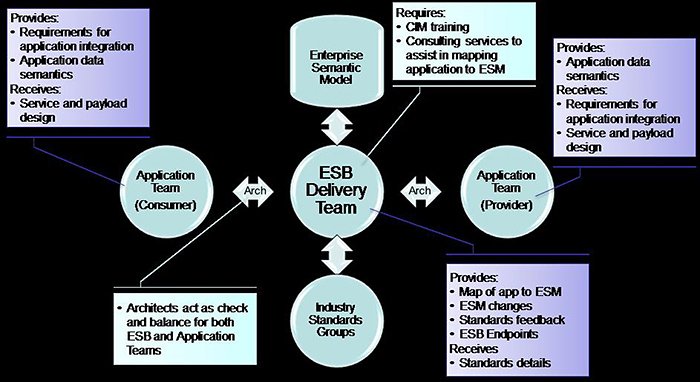In the digital era, grid modernization involves the addition of devices and systems that produce data – and lots of it. That trend inevitably leads to the use of apt terms such as ‘Big Data’ and the colorful, if daunting, metaphor ‘tsunami.’
Pertinent questions thus arise from those charged with a utility’s technology roadmap:
- How can a utility manage, protect, and extract value from Big Data?
- What approaches offer investment protection?
The answers, taken together, are simple, though not necessarily easy. A holistic, standards-based approach to grid modernization that relies on an open architecture will offer the best means of data management, protection and value creation, while ensuring that related investments maintain their value. Supporting this mission and providing guidance is the Smart Grid Interoperability Panel 2.0, Inc.’s (henceforth SGIP) raison d’être.
Pursuing a holistic approach to these related objectives, however, requires a utility to transform itself as well, in order to optimize the business case for grid modernization and align operational and enterprise processes with the benefits that accrue from this path.
The fundamental concept here, of course, is interoperability – enabling devices, systems, and databases to talk to each other, with backwards and forwards compatibility. Another notion is equally important – ensuring that personnel in operations and the enterprise can securely access all pertinent data in a comprehensible form.
Enter: SGIP
SGIP, where I serve as board chair, was birthed by the National Institute of Standards and Technology (NIST) in 2009. It became a member-driven and-funded organization in 2013, placing the power industry’s destiny into its own hands.
SGIP, along with other organizations such as NIST, has been working to guide the power industry to an interoperable future. We are accomplishing this task by attracting the widest possible membership and following a methodical process of identifying useful, existing standards, and gaps in those standards, and coordinating standards development organizations’ work to harmonize the industry’s path forward.
The path forward in the context of Big Data management, protection, and applications includes the adoption of the Common Information Model (CIM) and other pertinent standards – the focus of this article. I’ll describe the thinking behind such a solution, articulate the nature of Big Data’s management and benefits, and provide an illuminating case study from DTE Energy on the adoption of the CIM.
The nature of Big Data
Smart Grid largely focuses on the distribution system, where intelligent electronic devices (IEDs) are proliferating in substations and on the network’s feeders. IEDs range from smart meters to voltage, current and fault sensors to phasor measurement units (PMUs). IEDs are acquiring greater functionality as their prices drop, so this trend will continue. Grid operators must extract full value from them to optimize the business case for their implementation.
IEDs generate both operational and non-operational data. Often they are installed by operations technology (OT) staff seeking operational data to run the grid. OT staff may not be aware of IEDs’ value in generating non-operational data for enterprise use or, due to cultural factors, may not want enterprise information technology (IT) staff involved. But failure to exploit both data streams for the utility’s overall benefit leaves up to 80 percent of the IEDs’ potential value on the table.
In a holistic approach to grid modernization, an organization must exploit non-operational data to extract full value from IEDs. In fact, IEDs’ generation of non-operational data is increasing as vendors seek to differentiate their products by adding new functionality. All stakeholders within the organization, particularly enterprise business units, must have access to non-operational data – thus the goal of holistic data management.
The identification, extraction, routing, and use of operational data has been clear for some time. The role of non-operational data must catch up. Be forewarned: exploiting non-operational data will require OT/IT cooperation – a fundamental, historic challenge, but an opportunity for de-siloing.
To be useful, non-operational data must be collected and routed across the firewall to an enterprise data repository, connected to an ‘enterprise data mart’ or ‘virtual data mart’ accessible to business units for value creation. (By ‘virtual’ I mean a federated data server, which sits on top of and is logically linked to existing data repositories.) One major benefit is a switch from time-based to condition-based maintenance and the ability to anticipate equipment failure before it impacts service, saving time and money, and contributing to reliability.
Now, add the need to encourage and analyze data from social media initiated by customers who may report or even photograph outages and their causes and integrate that into the two, aforementioned data streams. Perhaps we should call this emerging area ‘Big Data Plus.’
Drivers for managing Big Data
Operational data, of course, is required for maintaining the grid and it supports energy management systems, distribution management systems, and outage management systems as well as the applications that ride on them for greater reliability and improved efficiencies. Non-operational data can further enterprise goals for energy efficiency, load shaping and capital deferral, to name a few benefits. Making meter data accessible to customers may be a regulatory mandate, but it also supports demand response, dynamic pricing, and other programs related to efficiency and reliability.
Open information architecture
Open information architecture is fundamental to our topic. Typically it is transparent, published, and based on industry standards. The obvious benefit is that it can be modified and has the ability to accommodate the widest range of technologies, software, and applications that come along. Consequently, it is a foundational element that offers investment protection.
It wasn’t until the 1990s that the power industry grasped the value of open architecture and standard data links. It precluded vendor lock-in, which promised to hold down costs. It offered the basis for a modular, multi-vendor approach as well as being upgradable. With the industry’s embrace of the CIM, reflected in the standards IEC 61968 for generation and transmission and IEC 61970 for distribution systems and DMS, software, too, matured.
An open architecture offers the foundation for two levels of applications. One is local in nature, by which I mean distributed intelligence in the control center or in substations and out on distribution feeders. Local applications work based on a subset of the entire system’s data. The other level consists of centralized, enterprise-wide apps, which operate using the superset of system data.
A hybrid arrangement that incorporates both centralized and distributed intelligence and applications offers the most flexibility, speed and value. Local, distributed intelligence and applications drive automated responses to grid conditions and free up data network bandwidth and central processing for higher priorities. The centralized approach can drive automation as well, but also includes human operators when circumstances merit it.
Solutions: CIM, other pertinent standards
The CIM is fundamental to our focus here. It is an open standard for representing power system components originally developed by the Electric Power Research Institute (EPRI). It has become a series of standards under the aegis of the International Electrotechnical Commission (IEC).
Those CIM-related standards include IEC 61970-301, a semantic model that describes the components of a power system and the relationships between them. IEC 61968-11 extends this model to other aspects of software-based data exchange, including asset tracking, work scheduling, and customer billing. IEC 62325-301 applies to data exchanged between participants in electricity markets.
The CIM illustrates the strengths of the open architecture, industry standards and software integration approach pursued by SGIP. For instance, when a utility purchases an EMS for generation and transmission systems from a vendor, it typically comes with a suite of applications. If the utility wishes to add another application, say, optimal power flow (OPF), from a different vendor, it may not be easily integrated because the databases setup by the EMS are proprietary – unless the CIM is implemented.
That’s because each software app has three parts: input, algorithm (for processing), and output. The means for input and output are structured based on the related databases. If the databases have a proprietary structure that limits the choice of applications, now and into the future, you’re stuck. Thus, one key value of CIM is its flexibility in defeating vendor lock-in.
A CIM ‘connector’ can serve as an interim solution. An EMS supplier can keep its proprietary, real-time database structure for performance reasons, but take this real-time information and the information about the power system network model out of the proprietary database and deliver it to an industry standard format – in this case, the CIM – and the CIM connector allows the use of any application that complies with the CIM format.
Standards for data security
Effective management of Big Data, of course, includes security. Among the 16 foundational standards identified by NIST are three that figure in data security, including:
- AMI-SEC for AMI and Smart Grid end-to-end security
- IEC 62351 for information security for power system control operations
- IEEE 1686 for the security of IEDs
 Further, in response to President Obama’s Executive Order 13636 in 2013, NIST has created a voluntary, iterative Framework for Improving Critical Infrastructure Cybersecurity, released this past February. This follows on the heels of NIST’s NISTIR 7628 – Guidelines for Smart Grid Cyber Security, issued in four volumes beginning in 2010. (The Introduction to NISTIR 7628 was written by the original SGIP’s Cyber Security Working Group.)
Further, in response to President Obama’s Executive Order 13636 in 2013, NIST has created a voluntary, iterative Framework for Improving Critical Infrastructure Cybersecurity, released this past February. This follows on the heels of NIST’s NISTIR 7628 – Guidelines for Smart Grid Cyber Security, issued in four volumes beginning in 2010. (The Introduction to NISTIR 7628 was written by the original SGIP’s Cyber Security Working Group.)
In support of NIST’s efforts, SGIP has issued or is currently producing numerous deliverables. The NISTIR 7628 Users Guide is available now and it covers implementation of cyber security practices detailed in NISTIR 7628’s first volume. SGIP currently is mapping NISTIR 7628 to the Framework and producing three related white papers, including a case study on the risk management process (RMP) and papers on defense in depth and cloud computing. We are working on a privacy awareness self-assessment tool as well.
Case study: DTE Energy
Nearly a decade ago, DTE Energy recognized the inherent limitations of point-to-point, custom integrations, which includes a high cost in time and money. DTE sought to ensure that future technology additions, including advanced metering infrastructure (AMI), would be scalable, maintainable, secure, and able to evolve as related technology changed. (Headquartered in Detroit, DTE’s regulated subsidiaries, DTE Electric and DTE Gas, together serve more than 3 million residential, business, and industrial customers throughout Michigan.)
After winning a stimulus grant for AMI in 2010 for its SmartCurrents project, DTE subsequently settled on using an Enterprise Semantic Model (ESM) and supporting architectural concepts such as the Enterprise Service Bus (ESB). The CIM served as the basis for the ESM. The utility established three guiding principles for its work:
- The CIM – and related standards IEC 61968 & 61970 – is the most pertinent NIST-recommended standard for Smart Grid interoperability and SmartCurrents IT work would be compliant with it.
- All application interfaces would be based on the ESM, which requires standard names for standard things.
- A centralized project team would ensure development of ESM-compliant application interfaces.

Point-to-point Integration – complex and difficult to maintain
DTE wisely added a key ingredient for success: a governance structure that included executive support, staff training and methodical documentation. The combination of a sound technical approach with effective ‘people processes’ carried the day.
Sounds good on paper but, of course, there were lessons learned en route to realizing tangible benefits, as documented in a SGIP case study by its Smart Grid Implementation Methods Committee:
- First, just a couple years ago, guidance for such an implementation remained immature.
- Second, changing a utility’s information architecture also means changing the organizational culture – and that remains a challenge.
- Third, the upfront disruption and extra effort fueled some pushback from staff.
Additionally, though the CIM fit the electric business well, the fit was not as immediate on the gas side – other information models might be applied. Greater education and training around the benefits of the CIM and ESB might garner more support for such an initiative. Reaching out to external parties and processes can build internal domain expertise, via greater participation in the CIM User Group (a subgroup of the UCA International Users Group) and leveraging outside expertise on the technologies involved gained by other implementations. A fully developed maintenance plan is needed to systematically deal with CIM changes.

Smart Grid Conceptual Model
Yet incremental successes at DTE began to illuminate the benefits and that provided a positive basis to build on. The cultural shift at DTE remains underway – underscoring the importance of an appetite for change – but with the CIM, ESM, and ESB in place, the reduction in integration timeframes and cost has been notable. While the benefits of the CIM and related standards are intuitive, DTE’s case is one of the first to be well-documented, if not fully quantified. (DTE currently does not have an organization-wide method for precisely measuring these benefits, though it is pursuing one.)
In summary, DTE’s tangible benefits included reduced time to integration delivery, resulting in:
- Cost savings
- Improved staffing agility, which provides greater efficiency
- The groundwork being laid for potential external interoperability
- A common, cross-organizational vocabulary, which developed through the use of standardized business/IT terms, improving communications and saving time

Relationships between the ESB Delivery Team and the other DTE teams and systems
The time to delivery of services using the CIM and the ESM at DTE has decreased by as much as a ratio of 4 or 5 to 1. An established message structure and cross-organizational vocabulary has eliminated time spent finding agreement on a message structure. There’s an upfront cost to implementing the CIM message for the first time, but the total cost of ownership drops because the initial effort is not repeated for every new interface.
Conclusion
As the DTE case illustrates, utility leaders may benefit from addressing their organization’s appetite for change prior to potentially disruptive projects such as implementing the CIM. Technology change and organizational change go hand-in-hand; the difficulty in achieving the latter should not be underestimated. In-house, domain expertise in approaching Big Data management should be widely shared. Participation in related, external standards processes is crucial as well.
As the orchestrator of the power industry’s standards processes, SGIP benefits from the most diverse possible membership. This helps inform its deliverables, including guidance on managing Big Data and related cyber security practices.
Four years ago, I submitted written testimony to the House Committee on Science and Technology’s Subcommittee on Technology and Innovation and what I said then remains true today:
“As we strive for interoperability across Smart Grid’s system of systems, we strive for… getting all the devices and infrastructure to speak a common language, use common interfaces and really work in unison… [This] is a new reality for both suppliers and customers that have traditionally operated in silos… This provides confidence in the technology investment and, ideally, a better return on the investment due to fewer, more easily managed implementations and/or integrations.
To address awareness and risk aversion, we need engagement, active participation and collaboration among a fully representative set of stakeholders. Being part of the process is paramount to trusting the process and its outcomes. The SGIP embodies and promotes these principles.”
In short, industry stakeholders have been empowered to help determine their own destiny through participation in SGIP (www.sgip.org). Join us or buckle up for the ride of your life. Disruptive forces are loose in the land. This demands that we become proactive in transforming our organizations and laying the foundation for future value with a holistic approach to open architecture and the CIM for interoperability and Big Data management.
The means to succeed are at hand. Carpe diem!
About the Author
 John McDonald is Director, Technical Strategy and Policy Development for GE Energy’s Digital Energy business with 40 years of experience in the electric utility transmission and distribution industry. He received his B.S.E.E. and M.S.E.E. (Power Engineering) degrees from Purdue University, and an M.B.A. (Finance) degree from the University of California-Berkeley.
John McDonald is Director, Technical Strategy and Policy Development for GE Energy’s Digital Energy business with 40 years of experience in the electric utility transmission and distribution industry. He received his B.S.E.E. and M.S.E.E. (Power Engineering) degrees from Purdue University, and an M.B.A. (Finance) degree from the University of California-Berkeley.
John is a Fellow of IEEE, and was awarded the IEEE Millennium Medal in 2000, the IEEE Power & Energy Society (PES) Excellence in Power Distribution Engineering Award in 2002, and the IEEE PES Substations Committee Distinguished Service Award in 2003. He is Past President of the IEEE PES, a Vice Chair of the Texas A&M University Smart Grid Center Advisory Board and member of the Purdue University Office of Global Affairs Strategic Advisory Council, a member of the IEEE PES Region 3 Scholarship Committee, the VP for Technical Activities for the US National Committee (USNC) of CIGRE, the Past Chair of the IEEE PES Substations Committee, and Chair of the Smart Grid Consumer Collaborative (SGCC) Board. John was the IEEE Division VII Director in 2008-2009. John was on the Board of Governors of the IEEE-SA (Standards Association) in 2010-2011, focusing on long term IEEE Smart Grid standards strategy.
Mr. McDonald was elected to Chair the NIST Smart Grid Interoperability Panel (SGIP) Governing Board for 2010-2012, and is currently the Chairman of the SGIP 2.0, Inc. Board of Directors and a member of the Executive Committee.







